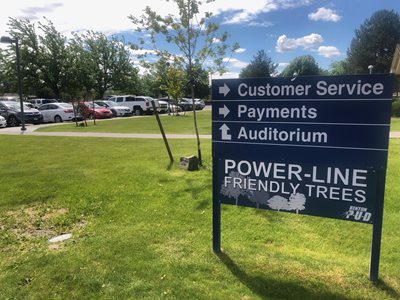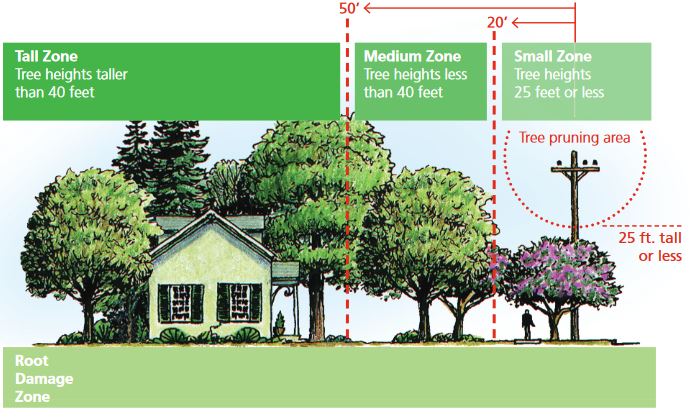Trees are an important part of our community and add to our quality of life. They add to your home value, provide shade, and help improve your home’s energy efficiency. Trees also play an important part of carbon reduction in our environment.
If not properly cared for trees may cause hazardous situations. Tree branches growing into electrical lines can cause power outages, property damage, or personal injury. These hazards can be prevented by planting appropriately near power lines, proper tree pruning, and in some cases, removal and replanting of “power line friendly” trees.
It is Benton PUD’s practice to prune and/or remove trees in close proximity to primary high-voltage overhead lines. Customers are responsible for pruning and/or removing trees growing into secondary lines that go directly to your home or business, as well as maintaining access to underground electrical equipment. Contact us prior to pruning near secondary lines to request that we disconnect your service. We will disconnect your service free of charge during regular work hours to allow you to prune your trees safely.
Benton PUD’s tree program was developed to ensure quality tree care practices and help customers plant the right trees near utility lines and equipment. The benefits of the program have been healthier trees, less outages, and long-term savings to Benton PUD and our customers. We are a recipient of the Tree Line USA award for our commitment to quality tree care practices, public education regarding tree planting for energy conservation, and appropriate placement near utility lines and community tree planting.
Brian Cramer
(509) 585-5399
cramerb@bentonpud.org
 Benton PUD displays trees that are safe to plant near power lines outside of our office in Kennewick. Come take a look! You can find them to the left of the lobby.
Benton PUD displays trees that are safe to plant near power lines outside of our office in Kennewick. Come take a look! You can find them to the left of the lobby.
It’s important to practice electrical safety when landscaping your home this spring and plant trees that are slow-growing near power lines so you don’t run into issues with utility equipment.
Tree branches growing into electrical lines can cause power outages, property damage, or personal injury. With proper planning you can help prevent these hazards. The rule of thumb: plant taller trees furthest away from power lines.
Small Zone
This utility-friendly zone is only for trees and shrubs that grow no more than 25 feet tall. These are called Class I trees.
Medium Zone
This zone is 20 to 50 feet away from a power pole and line. Here, mature trees should be no more than 40 feet tall. The extra space reduces the chance of tree branches or roots from contacting overhead or underground lines. Look for Class II trees to plant in this zone.
Tall Zone
This zone is at least 50 feet or more away from a power line or pole. It is the only zone where you should plant trees that grow over 40 feet tall. These are Class III trees.
What is a weed tree?
Weed trees are species of trees with high seed germination rates, meaning they grow rapidly and colonize quickly. The issue with these trees is that they become very invasive to your property, and can also pose a risk to utility lines and cause problems with equipment.
How can you keep weed trees at bay?
Luckily, you can manage the presence of weed trees on your property. The key is pulling them out of your yard early. If you pull them from your yard while they're a small seedling, you can save a lot of time and effort in the long run. If left untreated, you may need a professional to come and do expensive tree work to remove them.
What are some weed trees in our area?
- Cottonwoods & Poplars (Populus species)
- Weeping Willow & Australian Willow (Salix species)
- Silver Maple (Acer saccharinum)
- Tree of Heaven (Ailanthis altissima)
- Russian Olive (Elaeangnus angustifolia)
- Black Locust (Robina pseudoacacia)
- Elms (Ulmus species)
The proper location of a tree will improve your home's energy efficiency. The more summer shade that falls on sun-exposed windows, roofs, and walls, the cooler the temperature will be inside your home. By planning your landscape, you can achieve 10% to 40% energy savings.
- Deciduous trees provide nice shade in the summer and then lose their leaves in the fall, allowing the winter sun to help warm buildings and reduce winter heating costs. Deciduous trees are recommended for the south and west sides of your home.
- Using trees as windbreaks on the north or windy side of your house also helps increase energy efficiency. Evergreen trees provide the best protection, although low-branching deciduous trees help too.
- Shading air conditioning units can increase each unit's operating efficiency, but be careful that landscaping does not obstruct air circulation around the unit.
- Trees and shrubs planted close to the foundation of a building create a "dead air" space which reduces cold winter wind currents and slows the escape of heat. In the summer, this same space helps prevent heat gain.
What should I consider before selecting and planting a tree?
Don’t plant in a location near overhead and underground utility lines, including equipment such as pad-mount transformers and streetlights. Consider the location of buildings, sidewalks, and streets and future uses of the site. Strategically planted trees can also improve a home’s energy efficiency. Also consider the size of planting space available and the existing trees and plants.
Who trims trees by the power lines?
Only qualified tree trimmers hired by utilities are allowed to trim trees near high-voltage power lines. These workers know how to trim trees to keep them healthy and make sure branches won’t touch nearby lines.
How close can I plant a tree to a power line?
Avoid planting trees directly under power lines. If you are planting a tree within 30 feet of a power line, choose a tree that will grow no higher than 25 feet. Trees and shrubs planted over underground utilities may be damaged or completely removed if utility lines must be dug up for service. Roots from trees and plants can also cause problems as they grow.
Are trees under power lines removed?
Often what starts as a small tree planted below a power line can grow into a big problem, with impacts to service reliability and potential danger to our linemen. Many trees have to be pruned so heavily and frequently that they ultimately decline, decay, or become a hazard. While the natural reaction is to “save” such trees, replacement is the most logical choice. Benton PUD will remove potential problem trees at no cost to you and also give you a certificate towards the purchase of a power line friendly tree.
Are there types of trees that I can plant near power lines?
There are many options for power line friendly trees. Stop by our Kennewick office to see examples of several types, review this page to learn more, or contact us for more detailed information. We are happy to answer questions.
I have electrical equipment in my yard. May I plant around it?
Electrical equipment such as pad-mounted transformers and switch cabinets, or tops of underground vaults, need to be kept free of obstructions for service accessibility and for air circulation to prevent equipment failure. During power outages crews often find fences, shrubs, and trees that have been placed or planted in front of electrical equipment that have to be removed to provide service. Removing these obstacles takes time and delays restoring power.
The front of the transformer must be free of any obstructing material so that it is clearly visible (12 feet clearance). Plantings or fencing may be placed around two sides and the back provided that a 3 foot clearance is maintained. Trees planted within 15 feet of the transformer may eventually require removal if tree roots or foliage hinder service or maintenance of the transformer. The top of the transformer must be completely unobstructed.
I'm concerned about how a tree looks after it has been trimmed. When a tree grows into a power line, what technique does a tree trimmer use?
Benton PUD’s pruning practice uses the technique of directional pruning, which leaves intact the branches growing away from power lines. The branches growing towards the power lines are cut at a lateral branch or stem. V-pruning and side pruning are the two main variations of directional pruning. Over time, trees develop a more natural appearance and are healthier than trees topped flat. This follows the standards set by the National Arbor Day Foundation and the International Society of Arboriculture.
Can I trim my trees by the power lines?
Never attempt to prune trees near power lines. Benton PUD will evaluate the trees and potentially remove them. This will be at no cost to you and will also include a certificate towards the purchase of a power line friendly tree.
If you are planning to do any digging the first thing you want to do is call 8-1-1 for the Utilities Underground Location Center. They will send someone to mark where your electric, gas, water, sewer, and cable lines are buried. The last thing you want to do is to hit one of these lines, causing a dangerous and expensive problem.
Trees, shrubs, and other forms of vegetation that grow too close to electrical equipment can cause problems for our crews and may need to be removed to allow crew access. Taking time to remove plantings delays our response time to an outage or other electrical emergency. Make sure to leave at least 10 feet from the front side of any equipment and three feet from the other three sides when your plants are fully grown.

.png?lang=en-US)
.png?lang=en-US&ext=.png)
